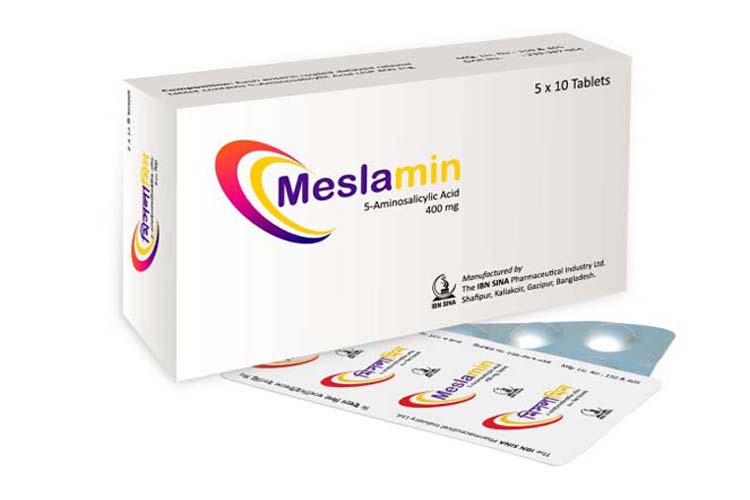
MESLAMIN
5-AMINOSALICYLIC ACID USP
| NAME | STRENGTH | PACK SIZE | DOSAGE FORM |
|---|---|---|---|
| MESLAMIN 400 DR TABLET | 400 MG | 50 S | TABLET |
Each enteric coated delayed release tablet contains 5-Aminosalicylic Acid (Mesalamine) USP 400 mg.
5-Aminosalicylic Acid is thought to be the major therapeutically active part of the sulfasalazine molecule in the treatment of ulcerative colitis. Sulfasalazine is converted to equimolar amounts of sulfapyridine and 5-Aminosalicylic Acid by bacterial action in the colon. The mechanism of action of 5-Aminosalicylic Acid (and sulfasalazine) is unknown, but appears to be topical rather than systemic. Mucosal production of arachidonic acid (AA) metabolites, both through the cyclooxygenase pathways, i.e., prostanoids, and through the lipoxygenase pathways, i.e., leukotrienes (LTs) and hydroxyeicosatetraenoic acids (HETEs), is increased in patients with chronic inflammatory bowel disease, and it is possible that 5-Aminosalicylic Acid diminishes inflammation by blocking cyclooxygenase and inhibiting prostaglandin (PG) production in the colon.
5-Aminosalicylic Acid delayed-release tablet is indicated for the treatment of mildly to moderately active ulcerative colitis and for the maintenance of remission of ulcerative colitis.
For the treatment of mildly to moderately active ulcerative colitis: The usual dosage in adults is two 400 mg tablets to be taken three times a day for a total daily dose of 2.4 grams for duration of 6 weeks. For the maintenance of remission of ulcerative colitis: The recommended dosage in adults is 1.6 grams daily, in divided doses. Treatment duration in the prospective, well-controlled trial was 6 months.
Patients with known hypersensitivity to salicylates or aminosalicylates or to any of the components of the 5-Aminosalicylic Acid (Mesalamin) tablets.
Use with caution, usually starting at the low end of the dosage range, because of the greater frequency of decreased hepatic, renal, or cardiac function, and of concomitant diseases or other drug therapy. Hypersensitivity: Some patients who have experienced a hypersensitivity reaction to sulfasalazine may have a similar reaction to mesalamine. Renal Function: Patients with a history of renal function impairment or disease may have worsening of renal function. Hepatic Function: Use with caution. There have been reports of hepatic failure in patients with preexisting liver disease. Sulfite Sensitivity: Some products may contain sulfites, which may cause allergic reactions in susceptible individuals.
The most common adverse reactions (incidence equal or less than 2%) are ulcerative colitis, headache, flatulence, liver function test abnormality and abdominal pain.
Pregnancy: Pregnancy Category C. There are no adequate and well controlled studies of 5-Aminosalicylic Acid use in pregnant women. 5-Aminosalicylic Acid delayed-release tablet should be used during pregnancy only if the potential benefit justifies the potential risk to the fetus. 5-Aminosalicylic Acid crosses the placenta. Lactation: 5-Aminosalicylic Acid and its N-acetyl metabolite are excreted into human milk. Caution should be exercised when 5-Aminosalicylic Acid delayed-release tablet is administered to a nursing woman.
Nephrotoxic agents (including NSAIDs): Increased risk of renal adverse reactions. Thiopurines (eg, azathioprine, mercaptopurine): The risk of leukopenia may be increased.
There is no specific antidote for mesalamine overdose and treatment for suspected acute severe toxicity with Meslamin should be symptomatic and supportive. This may include prevention of further gastrointestinal tract absorption, correction of fluid electrolyte imbalance, and maintenance of adequate renal function. Meslamin is a pH dependent delayed-release product and this factor should be considered when treating a suspected overdose.
Store in cool and dry place (below 30°C), protect from light. Keep out of reach of children.
Each box contains 10X5 tablets in Alu-Alu blister pack.
